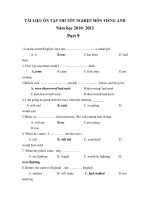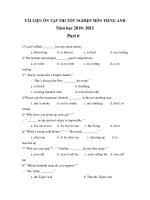tai lieu on tap thi tot nghiep mon tieng
Bạn đang xem bản rút gọn của tài liệu. Xem và tải ngay bản đầy đủ của tài liệu tại đây (92.55 KB, 10 trang )
TÀI LIỆU ÔN TẬP THI TỐT NGHIỆP MÔN TIẾNG ANH
Năm học 2010- 2011
Part 21
UNIT 1 :
Choose the item (A, B, C or D) that best completes the unfinished
statement (or best answers the ) about each passage.
John Fisher, a builder, and his wife Elizabeth wanted more living
space, so they left their small flat for an old 40-metre-high castle tower.
They have spent five years turning it into a beautiful home with six floors,
winning three architectural prizes.
‘I love the space, and being private,' Elizabeth says. 'You feel
separated from the world. If I'm in the kitchen, which is 25 metres above
the ground floor, and the doorbell rings, I don't have to answer it because
visitors can't see I'm in!'
'There are 142 steps to the top, so I go up and down five or six times a
day, it's very good exercise! But having to carry heavy things to the top is
terrible, so I never buy two bags of shopping from the supermarket at a
time. Apart from that, it's a brilliant place to live.'
'When we first saw the place, I asked my father's advice about buying
it, because we couldn't decide. After paying for it, we were a bit worried
because it looked awful. But we really loved it, and knew how we wanted it
to look.'
'Living here can be difficult - yesterday I climbed a four-metre ladder
to clean the windows. But when you stand on the roof you can see all the
way out to sea on a clear day, and that's a wonderful experience. I'm really
glad we moved.'
1. What is the writer trying to do in the text?
A. Describe how to turn an old tower into a house.
B. Recommend a particular builder
C. Describe what it is like to live in a tower
D. Explain how to win prizes for building work
2. From this text, a reader can find out
A. Why visitors are not welcome at John and Elizabeth's house.
B. Why Elizabeth exercises every day.
C. Why Elizabeth asked her father to buy the tower.
D. Why John and Elizabeth left the flat.
3. Which of the following best describes Elizabeth's feelings about the
tower?
A. She wanted it as soon as she saw it.
B. She likes most things about it.
C. She has been worried since they paid for it.
D. She finds it unsuitable to live in.
4. What problem does Elizabeth have with living in such a tall building?
A. Her visitors find it difficult to see if she is at home.
B. She feels separated from other people.
C. She cannot bring home lots of shopping at once.
D. It is impossible to clean any of the windows.
5. They were rather worried after paying for the castle because
A. they really couldn't afford it.
B. it was about to collapse.
C. it looked terrible at first. D. they were unable to take care of such
a large house.
READING
Read the passage and choose the best answer A, B, C or D to each .
During the teenage years, many young people can at times be difficult to
talk to. They often seem to dislike being ed. They may seem unwilling to talk
about their work in school. This is a normal development at this age, though it can
be very hard for parents to understand. It is part of becoming independent of
teenagers trying to be adult while they are still growing up. Young people are
usually more willing to talk if they believe that are asked out of real interest and
not because people are trying to check up on them.
Parents should do their best to talk to their sons or daughters about school
work and future plan but should not push them to talk if they don’t want to.
Parents should also watch for the danger signs: some young people in trying to be
adult may experiment with sex, drugs, alcohol or smoking. Parents need to watch
for any signs of unusual behaviour which may be connected with these and get
help if necessary.
1. This passage is taken from a…………
A. handbook for parents
B. school timetable.
C. teenage magazine
D. book for children
2. Why do adults sometimes find teenagers difficult to talk to?
A. because most teenagers are quiet.
B. because teenagers don’t want to talk to other people.
C. because teenagers think adults are not honest
D. because most teenagers hate adults.
3. When can you expect young people to be more talkative than usual?
A. when people talk to them because they are really interested and not just
checking on them.
B. when adults give them a lot of money to spend.
C. when adults talk to them about something other than their work in
school.
D. when adults talk to them about sex, alcohol and drugs.
4. Some teenagers experiment with drinking and smoking because
A. cigarettes and alcohol are available everywhere
B. cigarettes and alcohol are cheap
C. women like smoking and drinking them
D. they regard them as a mark of adulthood.
5. The word BEHAVIOUR in the passage most nearly means.
A. feeling
B. manners
C. activities D. reaction
READING
Read the passage and choose the best answer A, B, C or D to each .
Parents send their children to school to prepare for the time when they grow
up. Children learn their native language so that they will be able to communicate
fluently with other people around them. Moreover,they can preserve the valuable
culture and literature of their country.They learn foreign languages in order to
benefit from other country’s heritage. The more foreign languages they learn, the
more benefits they get. Children also learn maths to calculate, geography to know
about nature, and history to know about human beings and historical events.
Nearly everything they study at school has some practical uses in their life.
1. How many school subjects are mentioned in the passage ?
A. five
B. six
C. seven
D. four
2. According to the passage ,children learn history to know about......
A. the mankind
B. events of the history.
C. people and historical events.
D. practical uses of life
3. Why do children have to learn their native language ?
A. To learn foreign languages
B. To communicate fluently with other people around them.
C. To know about nature
D. To benefit from foreign countries’ heritage
4. Most of the things children learn at school ......
A. are useless
B. have no uses
C. are not necessary
D. have some practical uses.
5. Parents send their children to school to...
A. learn English
B. make them grow up
C. prepare for their future
D. play better
READING COMPREHENSION
The nuclear family, consisting of a mother, father, and their children, may
be more an American ideal than an American reality. Of course, the so-called
traditional American family was always more varied than we had been led to
believe, reflecting the very different racial, ethnic, class, and religious customs
among different American groups.
The most recent government statistics reveal that only about one third of all
current American families fit the traditional mold and another third consists of
married couples who either have no children or have none still living at home.Of
the final one third, about 20 percent of the total number of American household
are single people, usually women over sixty –five years of age. A small
percentage, about 3 percent of the total, consists of unmarried people who choose
to live together; and the rest, about 7 percent are single, usually divorced parents,
with at least one child. Today, these varied family types are typical, and therefore,
normal. Apparently, many Americans are achieving supportive relationships in
family forms other than the traditional one.
1. With what topic is the passage mainly concerned?
A. The traditional American family
B. The nuclear family
C. The current American family
D. The ideal family
2. The writer implies that __________
A. there have always been a wide variety of family arrangement in the
United States
B. racial, ethnic, and religious have preserved the traditional family structure
C. the ideal American family is the best structure
D. fewer married couples are having children
3. The word “current” in line 7 could best be replaced by which of the following?
A.typical
B. present
C. perfect
D. traditional
4. According to the passage, married couples whose children have grown or who
have no children represent __________.
A. 1/3 percent of households
B. 20 percent of households
C. 7 percent of households
D. 3 percent of households
5. Who gerneally constitutes a one- person household?
A. A single man in his twenties
B. An elderly man
C. A single woman in her late sixties
D. A divorced woman
READING COMPREHENSION
In the United States and Canada, it is very important to look a person
directly in the eyes when you are having a conversation with him or her. If you
look down or to the side when the other person is talking, that person will think
that you are not interested in what he or she is saying. This, of course, is not polite.
If you look down or to the side when you are talking, you may appear to be hiding
something; that is, it might seem that you are not honest. However, people who are
speaking will sometimes look away for a few seconds when they are thinking or
trying to find the right word. But they always turn immediately back to look the
listener directly in the eyes. These social “rules” are the same for two men, two
women, a man and a woman, or an adult and a child.
1. In the US and Canada, when you are having a conversation with someone,
________.
A. do not look directly in the eyes
B. it is impolite to look at the eyes of the speaker or hearer
C. you should look him or her directly in the eyes
D. look down or to the side
2. If you look down or to the side when the other person is talking, you ________.
A. will be thought to be not interested in the conversation
B. are very interested in what is being said
C. are very polite
D. are the interesting person
3. If you look down or to the side when you are talking,________.
A. the Americans are interested in you
B. you are thought to be dishonest
C. you are very polite
D. you are interested in the conversation
4. The speaker will sometimes look away because ___________.
A. he or she wants to end the conversation
B. he or she thinks that the hearer is not honest
C. the hearer is interested in what is being said
D. because they are thinking or finding the right word
5. These social “rules” are ________.
A. for men only
B. for women only
C. for children only
D. the same for everybody
READING COMPREHENSION
If you invite an American friend to join you to have dinner in a restaurant,
phone the rstaurant first to find out if you need a reservation to avoid a long wait
for a table. To make a reservation, just give your name, the number of people in
your group, and the time you plan to arrive. When you invite someone to dinner,
you should be prepared to pay the bill and reach for it when it arrives. However, if
your companion insists on paying his or her share, do not get into argument about
it. Some people prefer to pay their own way so that they do not feel indebted, and
those feelings should be respected. In most American restaurants, the waiter or
waitress’s tip is not added to the bill. If the service was adequate, it is customary to
leave a tip equal to about 15% of the bill. In expensive restaurants, leave a bit
more.
1. When you invite an American friend to have dinner in a restaurant ________.
A. a reservation is not necessary
B. you should make a reservation
C. there are always many tables available for you
D. you always have to wait for a long time
2. To make a reservation, you _________.
A. just give your name, the time you arrive and how many persons there
are in your group
B. have to give your address, the time you arrive and how many persons there
are in your group
C. just give your name, the time you arrive and your address
D. just give your name, the time you arrive and your telephone number
3. When you invite someone to dinner, you ________.
A. let hime to pay himself
C. give the bill to him
B. should prepare to pay the bill
D. share the bill with him
4. If your companion insists in paying his share, ________.
A. do not agree
B. it will be impolite
C. you should let him pay as he expects
D. you should get into argument with him
5. In most American restaurants, ________.
A. the tip is added to the bill
B. the tip is about 15% of the bill
C. you should not give the tip to waiters or waitresses
D. waiters and waitresses never get the tip
UNIT 3 :
1. Choose the item (A, B, C or D) that best answers the about the
passage:
Ever since humans inhabited the earth, they have made use of various
forms of communication. Generally, this is expression of thoughts and feelings has
been in the form of oral speech. When there is a language barrier, communication
is accomplished through sign language in which motions stand for letters, words,
and ideas. Tourists, the deaf, and the mute have had to make use of this form of
expression. Many of these symbols of whole words are very picturesque, and
exact, and can be use internationally; spelling, however, cannot.
Body language transmits ideas or thoughts by certain actions, either
intentionally or unintentionally. A wink can be away of flirting of indicating that
the party is only joking. A nod signifies nonlinguistic language can be found in
Braille ( a system of raise dots read with the fingertips), signal flags. Morse code,
and smoke signals. Road maps and picture signs also guide, warn, and instruct
people. While verbalization is the most common form of language, other systems
and techniques also express human thoughts and feelings.
1. Which of the following best summarizes the passage?
A. When language is a barrier, people will find other forms of
communication.
B. Everyone uses only one form of communication.
C. Nonlinguistic language is invaluable to foreigners.
D. Although other forms of communication exist, verbalization is the fastest.
2. Which of the following statements is NOT true?
A. There are many forms of communication in existence today.
B. Verbalization is the most common form of communication.
C. The deaf, and the mute use an oral form of communication.
D. Ideas and thoughts can be transmitted by body language.
3. Which form other than oral speech would be the most communication used
among blind people?
A. picture signs
B. Braille
C. Body language
D. Signal flags
4. How many different form of communication are mentioned here?
A. 5
B. 7
C. 9
D. 11
5. Sign language is said to be very picturesque and exact and can be used
internationally except for _______.
A. Spelling
B. Ideas
C. Whole words
D. Expressions.
2. Read the following passage then answer the 1 – 5. After each there
are four possible answers marked A, B, C or D. Choose the correct answer by
circling its corresponding letter A, B, C or D.
Do you ever give excuses that are not really true? When and why? It seems
that everybody tells lies – well, not big lies, but what we call “white lies”. The
only real are about when we lie and who we tell lies to. A recent study found that
in conversation people frequently stretch the truth. Here are some ways they do it.
People often lie because they want to hide some thing from someone. For
example, a son doesn’t tell his parents that he is dating a girl because he doesn’t
think they will like her. In stead, he says he is going to out with the guys.
Sometimes people lie because they don’t want to do something. For
example, someone invites you to a party. You think it will be boring so you say
that you are busy and can’t come.
Often we stretch the truth to make someone feel good. For example, your
friend cooks dinner for you, but it tastes terrible. Do you say so? No! You
probably say “Hmm, this is delicious!”
Other times we don’t want to tell someone bad news. For example, you
have just ad bad day at work, but you don’t want to talk about it. So, if someone
asks about your day, you just say everything was fine.
Telling “white lies” isn’t really bad. Most of the time people do it because
they want to protect a friendship.









